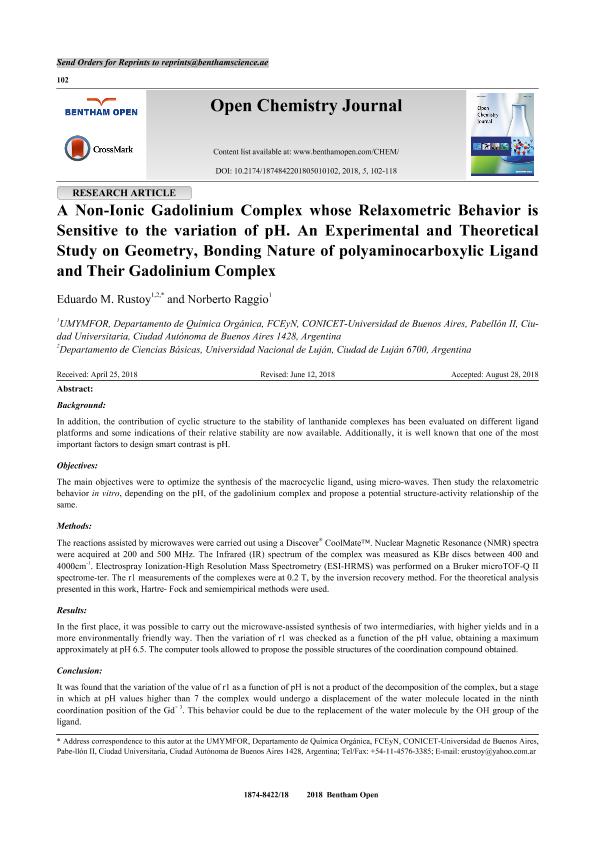Mostrar el registro sencillo del ítem
dc.contributor.author
Rustoy, Eduardo Miguel

dc.contributor.author
Raggio, Norberto

dc.date.available
2022-07-20T13:47:44Z
dc.date.issued
2018-10
dc.identifier.citation
Rustoy, Eduardo Miguel; Raggio, Norberto; A non-ionic gadolinium complex whose relaxometric behavior is sensitive to the variation of pH: An experimental and theoretical study on geometry, bonding nature of polyaminocarboxylic ligand and their gadolinium complex; Bentham Science Publishers; Open Chemistry Journal; 5; 1; 10-2018; 102-118
dc.identifier.issn
1874-8422
dc.identifier.uri
http://hdl.handle.net/11336/162632
dc.description.abstract
Background: In addition, the contribution of cyclic structure to the stability of lanthanide complexes has been evaluated on different ligand platforms and some indications of their relative stability are now available. Additionally, it is well known that one of the most important factors to design smart contrast is pH. Objectives: The main objectives were to optimize the synthesis of the macrocyclic ligand, using micro-waves. Then study the relaxometric behavior in vitro, depending on the pH, of the gadolinium complex and propose a potential structure-activity relationship of the same. Methods: The reactions assisted by microwaves were carried out using a Discover® CoolMate™. Nuclear Magnetic Resonance (NMR) spectra were acquired at 200 and 500 MHz. The Infrared (IR) spectrum of the complex was measured as KBr discs between 400 and 4000cm-1. Electrospray Ionization-High Resolution Mass Spectrometry (ESI-HRMS) was performed on a Bruker microTOF-Q II spectrome-ter. The r1 measurements of the complexes were at 0.2 T, by the inversion recovery method. For the theoretical analysis presented in this work, Hartre- Fock and semiempirical methods were used. Results: In the first place, it was possible to carry out the microwave-assisted synthesis of two intermediaries, with higher yields and in a more environmentally friendly way. Then the variation of r1 was checked as a function of the pH value, obtaining a maximum approximately at pH 6.5. The computer tools allowed to propose the possible structures of the coordination compound obtained. Conclusion: It was found that the variation of the value of r1 as a function of pH is not a product of the decomposition of the complex, but a stage in which at pH values higher than 7 the complex would undergo a displacement of the water molecule located in the ninth coordination position of the Gd+ 3. This behavior could be due to the replacement of the water molecule by the OH group of the ligand.
dc.format
application/pdf
dc.language.iso
eng
dc.publisher
Bentham Science Publishers

dc.rights
info:eu-repo/semantics/openAccess
dc.rights.uri
https://creativecommons.org/licenses/by/2.5/ar/
dc.subject
Gadolinium
dc.subject
Magnetic resonance imaging
dc.subject
Macrocyclic ligand
dc.subject
MOPAC/Sparkle
dc.subject.classification
Otras Ciencias Químicas

dc.subject.classification
Ciencias Químicas

dc.subject.classification
CIENCIAS NATURALES Y EXACTAS

dc.title
A non-ionic gadolinium complex whose relaxometric behavior is sensitive to the variation of pH: An experimental and theoretical study on geometry, bonding nature of polyaminocarboxylic ligand and their gadolinium complex
dc.type
info:eu-repo/semantics/article
dc.type
info:ar-repo/semantics/artículo
dc.type
info:eu-repo/semantics/publishedVersion
dc.date.updated
2022-07-15T15:03:28Z
dc.journal.volume
5
dc.journal.number
1
dc.journal.pagination
102-118
dc.journal.pais
Emiratos Árabes Unidos

dc.description.fil
Fil: Rustoy, Eduardo Miguel. Consejo Nacional de Investigaciones Científicas y Técnicas. Oficina de Coordinación Administrativa Ciudad Universitaria. Unidad de Microanálisis y Métodos Físicos en Química Orgánica. Universidad de Buenos Aires. Facultad de Ciencias Exactas y Naturales. Unidad de Microanálisis y Métodos Físicos en Química Orgánica; Argentina. Universidad Nacional de Luján. Departamento de Ciencias Básicas; Argentina
dc.description.fil
Fil: Raggio, Norberto. Consejo Nacional de Investigaciones Científicas y Técnicas. Oficina de Coordinación Administrativa Ciudad Universitaria. Unidad de Microanálisis y Métodos Físicos en Química Orgánica. Universidad de Buenos Aires. Facultad de Ciencias Exactas y Naturales. Unidad de Microanálisis y Métodos Físicos en Química Orgánica; Argentina
dc.journal.title
Open Chemistry Journal
dc.relation.alternativeid
info:eu-repo/semantics/altIdentifier/url/http://benthamopen.com/FULLTEXT/CHEM-5-102
dc.relation.alternativeid
info:eu-repo/semantics/altIdentifier/doi/http://dx.doi.org/10.2174/1874842201805010102
Archivos asociados
